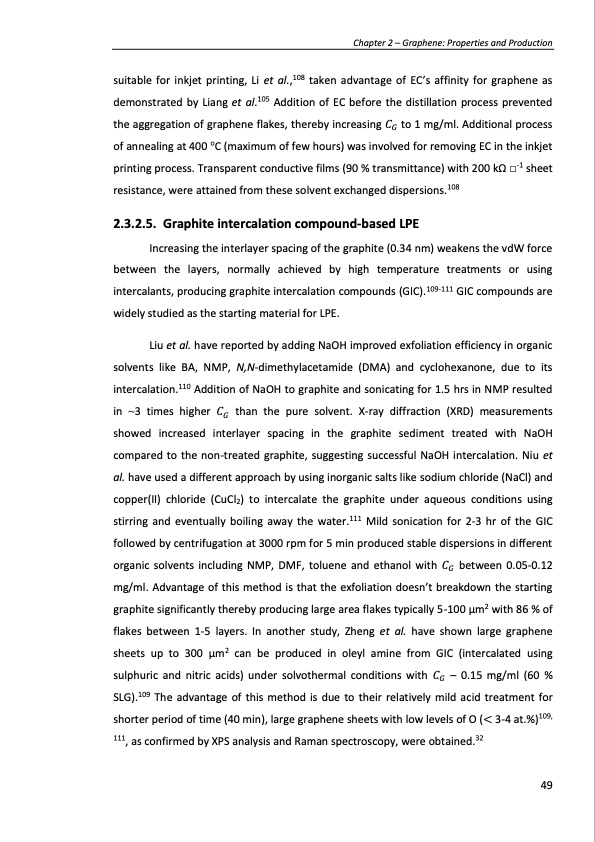PDF Publication Title:
Text from PDF Page: 049
suitable for inkjet printing, Li et al.,108 taken advantage of EC’s affinity for graphene as demonstrated by Liang et al.105 Addition of EC before the distillation process prevented the aggregation of graphene flakes, thereby increasing 𝐶𝐺 to 1 mg/ml. Additional process of annealing at 400 oC (maximum of few hours) was involved for removing EC in the inkjet printing process. Transparent conductive films (90 % transmittance) with 200 kΩ □-1 sheet resistance, were attained from these solvent exchanged dispersions.108 2.3.2.5. Graphite intercalation compound-based LPE Increasing the interlayer spacing of the graphite (0.34 nm) weakens the vdW force between the layers, normally achieved by high temperature treatments or using intercalants, producing graphite intercalation compounds (GIC).109-111 GIC compounds are widely studied as the starting material for LPE. Liu et al. have reported by adding NaOH improved exfoliation efficiency in organic solvents like BA, NMP, N,N-dimethylacetamide (DMA) and cyclohexanone, due to its intercalation.110 Addition of NaOH to graphite and sonicating for 1.5 hrs in NMP resulted in ~3 times higher 𝐶𝐺 than the pure solvent. X-ray diffraction (XRD) measurements showed increased interlayer spacing in the graphite sediment treated with NaOH compared to the non-treated graphite, suggesting successful NaOH intercalation. Niu et al. have used a different approach by using inorganic salts like sodium chloride (NaCl) and copper(II) chloride (CuCl2) to intercalate the graphite under aqueous conditions using stirring and eventually boiling away the water.111 Mild sonication for 2-3 hr of the GIC followed by centrifugation at 3000 rpm for 5 min produced stable dispersions in different organic solvents including NMP, DMF, toluene and ethanol with 𝐶𝐺 between 0.05-0.12 mg/ml. Advantage of this method is that the exfoliation doesn’t breakdown the starting graphite significantly thereby producing large area flakes typically 5-100 μm2 with 86 % of flakes between 1-5 layers. In another study, Zheng et al. have shown large graphene sheets up to 300 μm2 can be produced in oleyl amine from GIC (intercalated using sulphuric and nitric acids) under solvothermal conditions with 𝐶𝐺 – 0.15 mg/ml (60 % SLG).109 The advantage of this method is due to their relatively mild acid treatment for shorter period of time (40 min), large graphene sheets with low levels of O (< 3-4 at.%)109, 111, as confirmed by XPS analysis and Raman spectroscopy, were obtained.32 Chapter 2 – Graphene: Properties and Production 49PDF Image | PRODUCTION AND APPLICATIONS OF GRAPHENE AND ITS COMPOSITES

PDF Search Title:
PRODUCTION AND APPLICATIONS OF GRAPHENE AND ITS COMPOSITESOriginal File Name Searched:
graphene-production-applications.PDFDIY PDF Search: Google It | Yahoo | Bing
Salgenx Redox Flow Battery Technology: Power up your energy storage game with Salgenx Salt Water Battery. With its advanced technology, the flow battery provides reliable, scalable, and sustainable energy storage for utility-scale projects. Upgrade to a Salgenx flow battery today and take control of your energy future.
CONTACT TEL: 608-238-6001 Email: greg@infinityturbine.com (Standard Web Page)